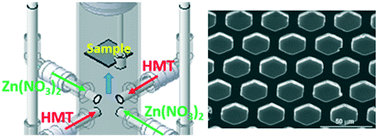Using a continuous flow reactor for aqueous lateral epitaxial overgrowth of low-dislocation-density ZnO layers on honeycomb-patterned structures
Abstract
In this paper, we demonstrate a low-temperature aqueous solution process, based on a continuous flow reactor design, for the long-duration continuous growth of ZnO epitaxial layers at a constant growth rate without interruption. Using a strategy of site-controlled epitaxial growth of ZnO, we grew patterned ZnO mesas having hexagonal honeycomb structures on top of lattice-matched patterned ZnAl2O4 buffer layers. Subsequently, we applied the continuous flow reactor for long-duration lateral epitaxial overgrowth (LEO) of ZnO layers on the honeycomb-patterned ZnO mesas. Dislocation etch pit analysis suggested a dislocation density for the coalesced LEO-grown ZnO layer of approximately 108 cm−2. X-ray diffraction revealed that the combination of LEO and a hexagonal honeycomb geometry is a promising approach for preparing wing-tilt-free thick ZnO layers displaying substantial strain relief. The micro-photoluminescence spectra of the overgrown wings featured a more intense band edge emission, confirming the significant improvement in crystalline quality in the wing regions.



 Please wait while we load your content...
Please wait while we load your content...